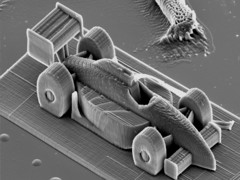Vienna University Sets Record with Two-Photon Lithography

285 µm racecar, created by two-photon lithography at the Vienna University of Technology. Courtesy of Vienna University
Latest News
March 14, 2012
Much of the 3D printing tech we look at here is at least partially judged by the available build envelope. The ability to print bigger objects is usually a plus, as is the case with the South African additive manufacturing facility under construction.
Occasionally though, smaller can be better. When it comes to potential breakthroughs in medical technology, size isn’t everything. Having an envelope large enough to print a jawbone is fantastic, but so is a printer able to build objects on the nano scale.
Vienna University has created a 3D printer using what they call “two-photon lithography” that is able to build objects with nanometer thick layers. The process uses mirrors to produce narrow focus laser that builds layers of liquid resin. Researchers gave the process its name because the resin must be able to absorb a minimum of two photons in order to set. This particular process also allows layers to be built without having to cure to topmost layer, which speeds up the build.
Until now, this technique used to be quite slow. The printing speed used to be measured in millimeters per second – our device can do five meters in one second. –Professor Jürgen Stampfl, TU Vienna Institute of Materials Science and Technology
With the new speed record in hand, researchers at Vienna University are working on developing bio-compatible resins for medical applications. Potential applications include using the process to create scaffolds for living cells to latch onto, speeding up the creation of biological tissue. Because the laser used in the process is so narrow, scientists are able to work in and around the cells without harming them, something other processes can’t match.
“We can also ‘write’ these structures in the presence of cells as we use an infrared laser, which is completely harmless for biological tissue,” said Professor Stampfl. “The two-photon lithography technique lets us do the writing in the same space as the cells — what we call in-vivo writing.”
Below you’ll find a video of the process in action.
Sources: Vienna University, BBC
Subscribe to our FREE magazine, FREE email newsletters or both!
Latest News
About the Author
John NewmanJohn Newman is a Digital Engineering contributor who focuses on 3D printing. Contact him via [email protected] and read his posts on Rapid Ready Technology.
Follow DE






